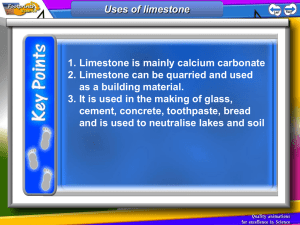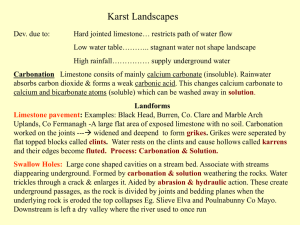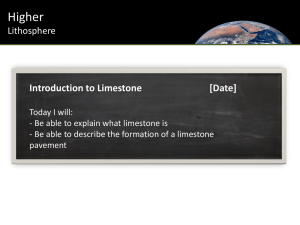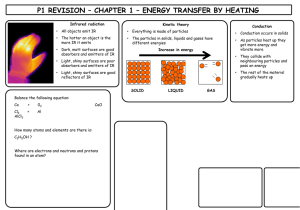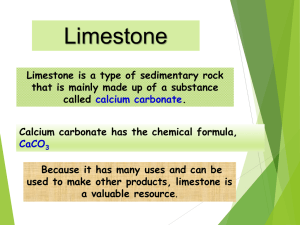Limestone Uplands
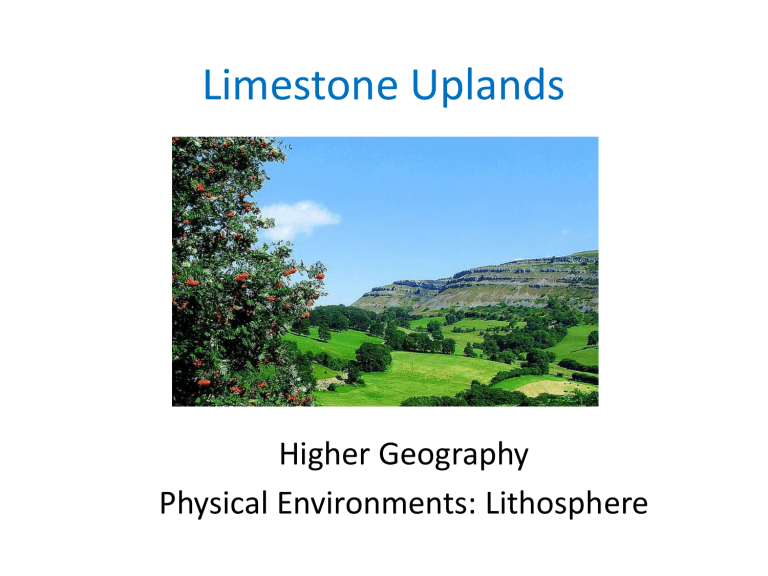
Limestone Uplands
Higher Geography
Physical Environments: Lithosphere
Limestone Uplands Outline
1. Characteristics and location of carboniferous limestone in the British Isles.
2. Formation of limestone landforms on the surface.
3. Formation of limestone landforms beneath the surface.
4. Identifying limestone landforms on O.S.
Maps.
Aims of the lesson
• To learn about the characteristics of carboniferous limestone and where it is found in the UK .
• To be able to describe the formation of a limestone pavement using diagrams.
Limestone
Limestone is a sedimentary rock.
It is created when sediments containing large amounts of dead sea creatures are turned into rock.
Contains large amounts of calcium carbonate (CaCO
3
).
Karst Landscapes
Carboniferous limestone creates distinctive landscapes called Karst .
The main Karst areas of the British Isles are:
– Midland Scotland
– South Wales
– Yorkshire Dales
– The Burren, Ireland
Yorkshire Dales
The Burren
Brecon Beacons, South Wales
Factors Influencing Karst Scenery
1. Rock Structure
– the rock is divided into blocks as a result of breaks between the rock beds ( bedding planes ) and vertical cracks ( joints ).
2. Permeability
– water passes easily through the rock by following the bedding planes and joints.
3. Carbonation & Solution bedding plane joint
Permeability
Carbonation
Limestone = Calcium Carbonate
Rainwater = Carbonic Acid
Carbonic Acid dissolves Calcium
Carbonate
This is called CARBONATION, a type of solution weathering.
Or … H
2
O + CO
2
= H
2
CO
3
CaCO
3
+ H
2
CO
3
= Ca(HCO
Hydrogen Carbonate
3
)
2
Calcium Carbonate Dilute Carbonic Acid Calcium
Karstic Landforms
Limestone Pavement
One of the most obvious features of an upland limestone landscape.
Limestone is exposed to weathering by glacial erosion.
Diagram Memory Activity
On the front desk is a series of diagrams showing the formation of a limestone feature.
One person at a time from each group will come up to the front and study the diagrams.
He/she will then report back to the group. By the end of the activity you should all have an exact copy of this diagram in your notes.
Limestone Pavements
1. Limestone is exposed to weathering by glacial erosion.
2. Carbonation and freeze thaw weathering exploit cracks in the rock called joints and bedding planes .
3. These gaps are widened until a series of rectangular blocks is created. This is the limestone pavement. The blocks are called clints and the joints are called grykes .
Limestone Pavements
Clint
Clint
Clint
Gryke
Clint
Clint
E.g. Malham Cove, Yorkshire Dales
Summary
So far we have learnt:
1. Limestone is a sedimentary rock that contains large amounts of calcium carbonate (CaCO
3
) .
2. Carboniferous limestone forms karst landscapes in the
British Isles e.g. Yorkshire Dales, The Burren, Brecon
Beacons.
3. Limestone is made up of blocks separated by joints and bedding planes .
4. Limestone is permeable – water can pass through it.
5. Limestone is vulnerable to chemical weathering – carbonation .
6. A major surface karst landform is the limestone pavement e.g. Malham Cove.
Revision Question
With the aid of annotated diagrams, explain the formation of a limestone
pavement. (6 marks)
Use you notes & p111 of the P&H
Environments textbook to help you
(diagram on p114).
Tips:
• Ensure you include a fully annotated diagram
• Include the processes involved e.g. explain the process of carbonation and freeze-thaw.
• Ensure your written answer is well structured and takes the reader through the formation process step by step.
1.
Limestone exposed to surface by glacial erosion.
2.
Structure of limestone.
3.
Processes of chemical & physical weathering.
4.
How is limestone changed?
5.
Named example.
Sample Answer: Limestone Pavement
Limestone pavements are a karstic landform made from carboniferous limestone. This sedimentary rock formed 350 million years ago and contains a high quantity of the calcium carbonate (1). A limestone pavement begins to form when a glacier erodes the topsoil and exposes the limestone beneath to the surface (1). At this point it is vulnerable to attack from both chemical and physical weathering processes.
Weak carbonic acid is created when carbon dioxide mixes with water in clouds (1). This acid rain falls onto the limestone and exploits natural breaks in the rock called joints and bedding planes (1). Over time the acid rain dissolves the limestone and widens the gap between the joints (1). This process is called carbonation (1). Eventually the surface is divided into a series of rectangular blocks called clints separated by gaps called grykes (1).
Freeze-thaw weathering can also contribute to the formation of this landform (1). Rainwater falls into the vertical joints and then freezes during cold nights (1). Once it freezes the water expands by 10% and exerts pressure on the sides of the rock, widening them over time (1).
An example of this landform is Malham Cove in the Yorkshire Dales (1).
Sample Answer: Limestone Pavement
Limestone pavements are a karstic landform made from carboniferous limestone. This sedimentary rock formed 350 million years ago and contains a high quantity of the calcium carbonate (1). A limestone pavement begins to form when a glacier erodes the topsoil and exposes the limestone beneath to the surface (1). At this point it is vulnerable to attack from both chemical and physical weathering processes.
Weak carbonic acid is created when carbon dioxide mixes with water in clouds (1). This acid rain falls onto the limestone and exploits natural breaks in the rock called joints and bedding planes (1). Over time the acid rain dissolves the limestone and widens the gap between the joints (1). This process is called carbonation (1). Eventually the surface is divided into a series of rectangular blocks called clints separated by gaps called grykes (1).
Freeze-thaw weathering can also contribute to the formation of this landform (1). Rainwater falls into the vertical joints and then freezes during cold nights (1). Once it freezes the water expands by 10% and exerts pressure on the sides of the rock, widening them over time (1).
An example of this landform is Malham Cove in the Yorkshire Dales (1).
Mark Your Work
Using the sample answer you have been given, mark your own work out of 6 marks.
Any points you have not included should be added as bullet points beneath your original answer.
Aims of the lesson
1. We will be able to describe the formation of a shake hole .
2. We will be able to describe the formation of a pothole and give a named example.
Shakeholes
A shakehole is a depression in the limestone landscape.
In some limestone areas there is a covering of boulder clay about two or three metres thick.
Shakeholes are formed where surface water washes the boulder clay away . They are usually found in groups .
Potholes (Sink Holes or Swallow Holes)
Surface and rain water do not flow far on exposed limestone, but infiltrate rapidly into the rock and soil.
A stream travelling over an impermeable rock will very quickly disappear when it has to travel over limestone.
These potholes can be many metres deep leading down to a series of subsurface features.
Pothole Formation
Pothole
Pothole
Gaping Gill: Second largest pothole in the UK
Review Questions
1. What is the difference between a shakehole and a sink hole?
2. What sort of type of material is found blocking a shakehole and how is it removed?
3. What is our named example of a pothole?
4. What factors could lead to a pothole growing in size?
Summary
In this lesson we have:
• Learnt that a shakehole is formed when boulder clay deposited in a limestone hollow
(doline) is removed by rivers .
• Learnt that a pothole is created by a river flowing over permeable limestone and flowing underground e.g. Gaping Gill .
Aims of the lesson
To carry out your own research on the following landforms:
1. Shakeholes
2. Potholes
3. Scars & Scree Slopes
4. Dry Valley
5. Gorge
Glaciokarstic
Features
BBC Website Research
Go to the following website: http://www.bbc.co.uk/scotland/education/int/geog
/limestone/index.shtml
Collect information in your notes on:
1. What is a glaciokarstic feature?
2. Shakeholes, Potholes, Scars & Scree Slopes, Dry
Valley, Gorge.
a) How was the feature formed?
b) Named example of landforms.
Glaciokarstic Features
That glaciokarstic landforms have been influenced by both limestone and glacial processes.
Scars & Scree Slopes
During the last ice age huge ice sheets scraped away the soil covered spurs in many valleys in the Yorkshire
Dales. Steep cliffs of bare rock were exposed. Because these scars are more liable to frost shattering and other forms of erosion they usually have scree slopes of broken rock below them.
Dry Valleys
During the last ice age the limestone was frozen to great depths. When the ice melted it carved out valleys over the frozen rock. When the limestone thawed out the surface water was able to infiltrate down through the rocks and the dry valleys were left with no surface water.
Gorge
During the meltwater phase of the last ice age, underground streams eroded vast caverns as huge volumes of water travelled through the limestone. Sometimes the roofs of these caverns can collapse exposing the
"underground stream" in a very steep sided gorge
Summary
So far we have learnt:
– That glaciokarstic landforms have been influenced by both limestone and glacial processes.
– Examples of glaciokarstic landforms:
• Scars & Scree Slopes e.g. Twistleton Scar or Raven Scar
• Dry Valley
Trow Gill Gorge
• Gorge
Sedimentary
Carbonation
ODD ONE OUT
Igneous Metamorphic
Exfoliation Freeze-thaw
Soil Creep
Dry Valley
The Burren
Rockfall
Pothole
Yorkshire
Dales
Landslide
Shakehole
Loch Lomond
Aims of the lesson
• We will be able to describe the formation of a cavern.
• We will be able to describe the formation of a stalactite, stalagmite and pillar.
Limestone Landforms Beneath the
Surface
Underground Landforms
Caverns & Caves
Joints & bedding planes close together.
River flows down pot-hole
Water dissolves the rock.
Caverns & Caves
Limestone dissolved by the water to form a cavern
Stalactites
Limestone
Pillar
Stalagmites
Cavern Formation
River flows down pot-hole and works its way through the joints and bedding planes.
This water is still acidic and so dissolves the limestone by carbonation .
Where the joints and bedding planes are close together , the limestone may be completely worn away to form a cavern .
Stalactites, Stalagmites & Pillars
Sequencing Activity
Read p113 of the P&H textbook.
In your groups, read the statements on the next slide carefully.
As a group try to decide what order you would put the cards into to describe the formation of stalactites, stalagmites & pillars.
Stalactites, Stalagmites & Pillars
1.
Water that has worked its way through joints & bedding planes enters the cavern and comes into contact with air. This causes it to lose some CO
2 and become less acidic.
2.
This less acidic water cannot hold onto as much of the dissolved calcium hydrogencarbonate.
3.
As water drips down from the cavern roof some of it evaporates . This leaves some calcium carbonate behind, which is deposited on the roof.
4.
These deposits build up over time to form finger like growths pointing downwards called stalactites . Some calcium carbonate also evaporates on the cavern floor forming a stalagmite .
5.
These are known as dripstone features that grow at a rate of around 7mm every year.
If the two connect, this forms a pillar . Excellent examples of these features are found in the Ingleborough Caves.
Stalactites, Stalagmites & Pillars
CaCO3 deposited
Stalactite Pillar
Water containing
CaCO3
CaCO3
Deposits build up over time
Stalagmite
REMEMBER!
Stalactites grow down from the cavern roof.
Stalagmites grow up from the cavern floor.
Stalactites, Stalagmites & Pillars
• http://www.youtube.com/watch?v=IKZ9EHew jZg
Review Questions
Describe and explain the formation of stalactite, stalagmites and pillars (dripstone features). You may wish to use diagrams in your answer. (6 marks)
Structure:
• Water moving through limestone – cavern formed.
• Water enters cavern – loses CO
2 .
• Calcium carbonate deposits build up.
• Finger like growth coming down from ceiling.
• Deposits build up on cavern floor.
• Eventually connect.
• Named example – Ingleborough Caves
Sample Answer: Stalactites,
Stalagmites & Pillars
Water that has worked its way through joints & bedding planes present in the limestone enters a cavern and comes into contact with air (1). This causes it to lose some CO
2 and become less acidic (1).
This less acidic water cannot hold onto as much of the dissolved calcium hydrogencarbonate (1). As water drips down from the cavern roof some of the calcium carbonate evaporates and is deposited on the roof of the cavern (1).
These deposits build up over time to form finger like growths pointing downwards called stalactites (1). Some calcium carbonate also evaporates on the cavern floor forming a stalagmite (1).
These are known as dripstone features that grow at a rate of around 7mm every year
(1). If the two connect, this forms a pillar (1). Excellent examples of these features are found in the Ingleborough Caves of the Yorkshire Dales(1).
Sample Answer: Stalactites,
Stalagmites & Pillars
Water that has worked its way through joints & bedding planes present in the limestone enters a cavern and comes into contact with air (1). This causes it to lose some CO
2 and become less acidic (1).
This less acidic water cannot hold onto as much of the dissolved calcium hydrogencarbonate (1). As water drips down from the cavern roof some of the calcium carbonate evaporates and is deposited on the roof of the cavern (1).
These deposits build up over time to form finger like growths pointing downwards called stalactites (1). Some calcium carbonate also evaporates on the cavern floor forming a stalagmite (1).
These are known as dripstone features that grow at a rate of around 7mm every year
(1). If the two connect, this forms a pillar (1). Excellent examples of these features are found in the Ingleborough Caves of the Yorkshire Dales(1).
Summary
Today we have learnt…
– How to describe the formation of a cave.
– How to describe the formation of stalactites, stalagmites and pillars, with reference to named examples.
On the Wall
Using the post-its on your desk, stick your answers to each question on the wall.
Fastest Team Wins!
1. What speed do stalactites grow on average?
2. What is our named example of:
– Limestone Pavement
– Cave
– Pothole
3. Describe the process of carbonation on limestone.
4. Name the 3 important characteristics of limestone.
5. What is the name given to a river that reappears from underground?
Aims of the lesson
• To give feedback on your progress so far.
• To describe the formation of gours in limestone caverns.
Gours
• These are ridges of calcium carbonate formed on cave floors.
• Formed as CO
2 is lost from streams flowing along the surface.
• Calcium carbonate is deposited.
Evaluation
On lined paper answer the following questions:
1. Why did you choose Higher Geography?
2. What grade are you hoping to gain?
3. How do you prefer to learn? Discussion?
Activities? PPQ? Notes from the board?
4. Is there anything you would change about the way your are learning in Geography?
Geography
Pictionary
RULES:
– One person per group will come up to the board and be given a word.
– Draw images to get your team to guess the word.
– Drawer cannot talk or write words!
What we have learnt so far…
Types of rock
Physical & Chemical
Weathering Processes
Mass Movement
What we have learnt so far…
Characteristics of carboniferous limestone
Surface Features
Underground Features
Tell me someone who…
1. Can name all 3 types of rock.
2. Knows the difference between erosion and weathering.
3. Can name 2 types of physical weathering.
4. Can name 2 types of chemical weathering.
5. Can name 3 factors that influence mass movement.
6. Can name a process of mass movement.
7. Can list 3 factors that influence karst scenery.
8. Can give a named example of a limestone pavement.
9. Can describe what a glaciokarstic landform is.
Aims of the lesson
• To revise the content that we learnt before the holidays.
Group Answer
Working in your groups, you are going to create the perfect answer to one of the questions on the whiteboard.
Before writing your answers, you should agree upon a plan that you must show to me.
Use the resources on your tables to help you.
Questions
1. Describe and explain the formation of stalactite, stalagmites and pillars (dripstone features). You must use diagrams in your answer. (6 marks)
2. With the aid of annotated diagrams, explain the formation of a limestone pavement. (6 marks)
3. Describe and explain the conditions and processes which encourage the formation of scree slopes. (6 marks)
Peer Marking
Pass your answer to another table.
You must now give another groups question a mark out of 6.
Use your sample answers & textbooks to help you.
Summary
So far we have…
• Revised what we have learnt in Higher
Geography so far.
Identifying Limestone Landforms on
OS maps
Identifying landforms on an OS map is one of the key skills you will need to develop.
There will be questions based on this in your exam.
Lesson Aim : To learn how to identify limestone landforms on an OS map.
OS Map Questions
You could be asked to look at the map and recognise the
evidence of limestone features.
You may also be asked to
explain how these features have formed.
You must use grid references
(6 figure) and only refer to what you can see on the map.
What can you see?
Swallow
Hole
Limestone Pavement
Limestone Scar
Resurgence Points
Activity
Turn to p112 in the Higher
Textbook.
Study the map extract of
Ingleborough.
Describe the evidence that suggests that Ingleborough is an area of Carboniferous
Limestone. (8 marks)
Tips:
• Identify various features shown on the map and ensure you name them and provide grid references
• You can also make general comments about the area that suggests it is limestone.
Extension
Choose one of the carboniferous limestone features you mentioned in Q1, and with the aid of annotated diagrams, explain its formation. (6 marks)
Summary
So far we have…
– Learnt how to recognise limestone landforms on
O.S Maps.
– Practiced how to answer O.S. Map PPQs.


